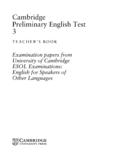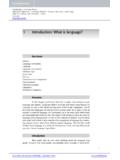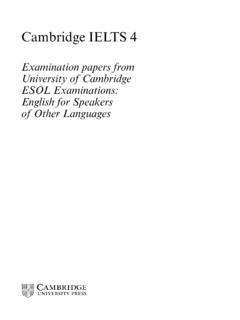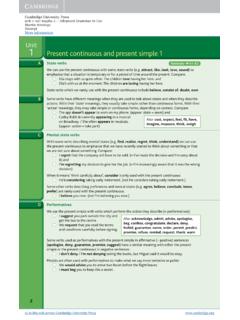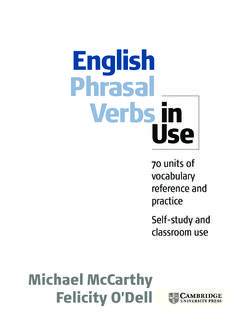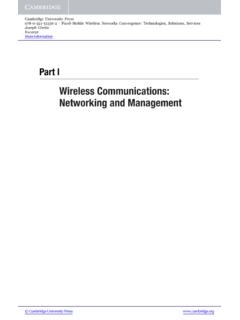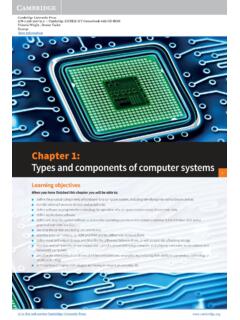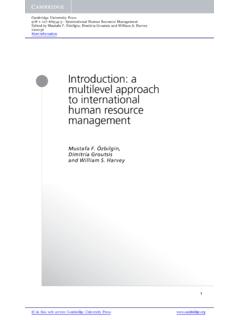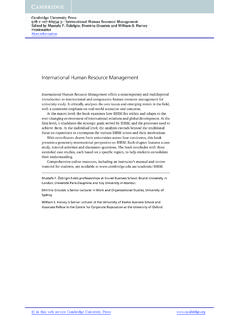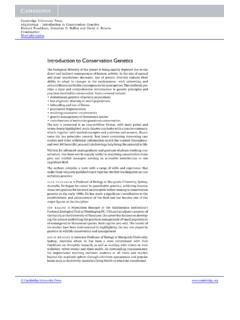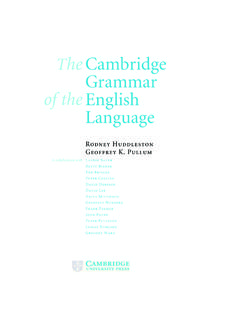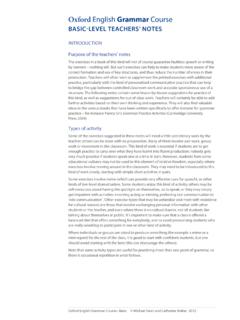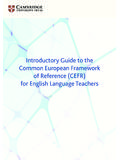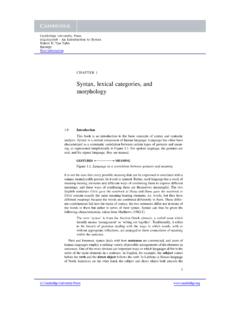Transcription of Cambridge Key English Test 1 - Cambridge University Press
1 Cambridge Key English Test 1. TEACHER'S BOOK. Examination papers from University of Cambridge ESOL Examinations: English for Speakers of Other Languages PUBLISHED BY THE Press SYNDICATE OF THE University OF Cambridge . The Pitt Building, Trumpington Street, Cambridge , United Kingdom Cambridge University Press . The Edinburgh Building, Cambridge CB2 2RU, UK. 40 West 20th Street, New York NY 10011 4211, USA. 477 Williamstown Road, Port Melbourne, VIC 3207, Australia Ruiz de Alarc n 13, 28014 Madrid, Spain Dock House, The Waterfront, Cape Town 8001, South Africa Cambridge University Press 2003. This book is in copyright. Subject to statutory exception and to the provisions of relevant collective licensing agreements, no reproduction of any part may take place without the written permission of Cambridge University Press . First published 1997. New edition 2003. Reprinted 2003.
2 Printed in the United Kingdom at the University Press , Cambridge Typeface Helvetica 10/13pt. System QuarkXPress [OD&I]. A catalogue record for this book is available from the British Library ISBN 0 521 52807 0 Student's Book ISBN 0 521 52808 9 Student's Book with answers ISBN 0 521 52809 7 Teacher's Book ISBN 0 521 52810 0 Cassette ISBN 0 521 52811 9 Set of 2 Audio CDs Contents Introduction Test 1 Key The background to the update Paper 1 33. of KET 5 Paper 2 35. The level of KET 6 Transcript 35. Waystage 6. Preparing for KET 7 Test 2 Key KET candidates 8 Paper 1 41. Language specifications 9 Paper 2 43. Further information 10 Transcript 43. KET content and marking Test 3 Key Paper 1 Reading and Writing 11 Paper 1 49. Paper 2 Listening 14 Paper 2 51. Paper 3 Speaking 16 Transcript 51. Grading, awards and results 19 Test 4 Key Paper 1 57. Paper 3 frames Paper 2 59.
3 Test 1 21 Transcript 59. Test 2 24. Test 3 27. Test 4 30. KET content and marking KET content and marking The KET examination consists of Paper 1 (Reading and Writing), Paper 2. (Listening) and Paper 3 (Speaking). Paper 1 1 hour 10 mins Reading and Writing 9 parts 50% of total Paper 2 approx 30 mins Listening 5 parts 25% of total (including 8 mins transfer time). Paper 3 8 10 mins Speaking 2 parts 25% of total Paper 1 Reading and Writing (1 hour 10 minutes). In the KET Reading and Writing paper, Parts 1 5 focus on reading and Parts 6 9. focus on writing. There is a total of 56 questions, with an example for each part. The time allowed for this paper is one hour and ten minutes. Reading texts Texts vary according to the different test focus of each part. In Parts 1, 4 and 5, texts are authentic but edited to bring vocabulary and structure within the grasp of students at this level.
4 Texts in other parts are specially written but based on authentic types to ensure task authenticity. Texts may contain some vocabulary or structures unknown to candidates, but they will be able to deduce the meaning from the context, and understanding of these words will not be necessary to complete the task. Most texts are short; no text exceeds 230 words. Part 1 Signs, notices, labels and other very short texts of the type found on roads, in railway stations, airports, shops, restaurants, schools, offices, etc. Part 2 Simple sentences with a connecting theme or simple narrative, of the type students at this level should be able to read and understand. Part 3 Texts based on the language used in the routine exchanges of daily life. Part 4 Factual text from a newspaper or magazine article, or similar source. Part 5 Factual text from a newspaper or magazine article, junior encyclopaedia or similar source.
5 11. KET content and marking Test focus Part 1 Reading for main message. Part 2 Reading and identifying appropriate vocabulary. Part 3 Reading and identifying appropriate response. Part 4 Reading for main idea(s) and specific detail; making use of interpretation strategies. Part 5 Reading and identifying appropriate structural word. Part 6 Reading and writing down words (focus on vocabulary and spelling). Part 7 Reading and writing down words (focus on structure and vocabulary). Part 8 Reading and writing down words (focus on content). Part 9 Reading and writing a short message (focus on communication of message, appropriacy, accuracy, vocabulary). Tasks Part 1 This is a matching task with five questions and eight options to choose between. Part 2 This is a three-option multiple choice with a lexical focus. There are five questions. Part 3 There are five multiple-choice questions (each with three options), which require candidates to complete five separate two-line exchanges; these are followed by a matching task with five questions and eight options to choose between, in the context of a short gapped dialogue.
6 Part 4 The task is either three-option multiple choice, or one involving a choice between Right/Wrong/Doesn't say. There are seven questions. Part 5 This is a three-option multiple-choice cloze task. There are eight questions. Part 6 This is a productive task with a lexical testing focus. Five common words are defined and the first letter of the answer is given. Students need to complete the word. Part 7 This is an open cloze task. Candidates are required to show control of structure and vocabulary in the context of a short letter (or two short notes) of the kind that students at this level might be expected to write. There are ten questions. Part 8 This is an information transfer task, requiring candidates to extract relevant information from a short input text and use it to complete some kind of form (for example, sports club membership form, visa application form, etc.)
7 There are five questions. 12. KET content and marking Part 9 Candidates are required to show that they can communicate a written message (25 35 words) of an authentic type, for example, a note or postcard to a friend. The instructions indicate the type of message required, who it is for and what kind of information should be included. Alternatively, candidates may be asked to read and respond appropriately to a short note from a friend. Candidates are asked to convey three pieces of information. Marks Candidates record their answers in pencil on a separate answer sheet within the time allowed. This involves marking the appropriate lozenge for each question in Parts 1 5, writing one word per question for Parts 6 and 7, writing a word, figure or phrase for each question in Part 8 and writing the note or other message asked for in Part 9 (see the photocopiable sample answer sheets at the back of the Student's Book).
8 One mark is given for each correct answer in Parts 1 8. Correct spelling is required in Parts 6, 7 and 8. There are 5 marks for Part 9 (see below for more details). The total score of a possible 60 marks is then weighted to 50% of the marks available over the whole test. Assessment of Part 9. An impression mark is awarded to each piece of writing using the criteria shown in the mark scheme on page 14. Candidates are expected to write a coherent message which clearly conveys all the pieces of information indicated in the instructions. Credit is given for reasonably correct grammar, spelling and punctuation, and appropriate use of vocabulary. However, writing at this level is not expected to be error-free and more weight is given to successful communication of the message than to absolute correctness. Where appropriate, candidates should show awareness of the conventions of note-writing by including a salutation and a signature in their note.
9 The mark scheme is used in conjunction with notes specific to each test. These task-specific notes indicate which three pieces of information the candidate is expected to include in the piece of writing. 13. KET content and marking Outline mark scheme for Part 9. Mark Criteria 5 All three parts of message clearly communicated. Only minor spelling errors or occasional grammatical errors. 4 All three parts of message communicated. Some errors in spelling, grammar and/or punctuation. 3 All three parts of message attempted. Expression may require interpretation by the reader. or Two parts of message are clearly communicated, but one part is unattempted. Only minor spelling errors or occasional grammatical errors. 2 Only two parts of message communicated. Some errors in spelling and grammar. The errors in expression may require patience and interpretation by the reader.
10 1 Only one part of message communicated. 0 Question unattempted, or totally incomprehensible response. Candidates are penalised for writing less than the minimum number of words ( fewer than 25) and for ignoring the conventions of note-writing by not providing a suitable opening and close to their notes. They are not penalised for writing too much, though they are not advised to do so. See the key for Part 9 of each paper for some sample scripts with task-specific notes and examiner's comments. Marking Answers to Parts 1 5 are scanned by computer. Parts 6 9 are double marked by a team of fully trained markers who are closely supervised at every stage. The marking of Part 9 requires special treatment. After the examination, a meeting is held with the Chief Examiner in which sample scripts are chosen to demonstrate the range of responses and different levels of competence achieved in the writing task.
